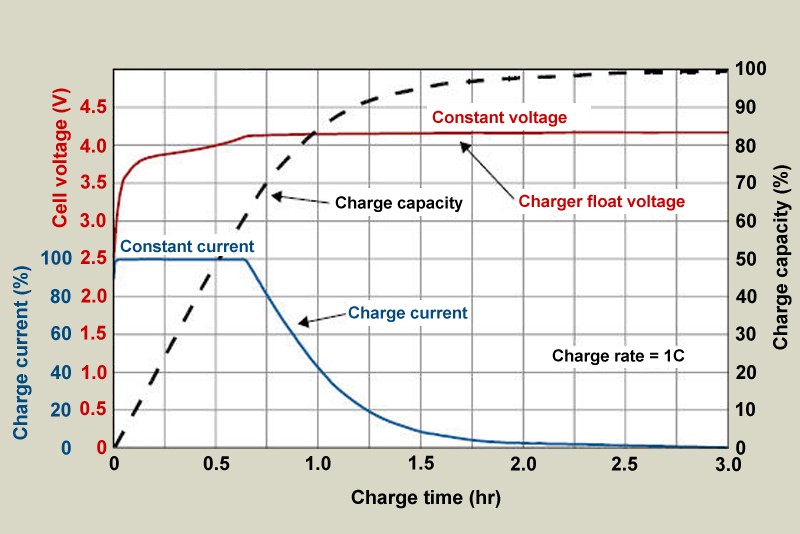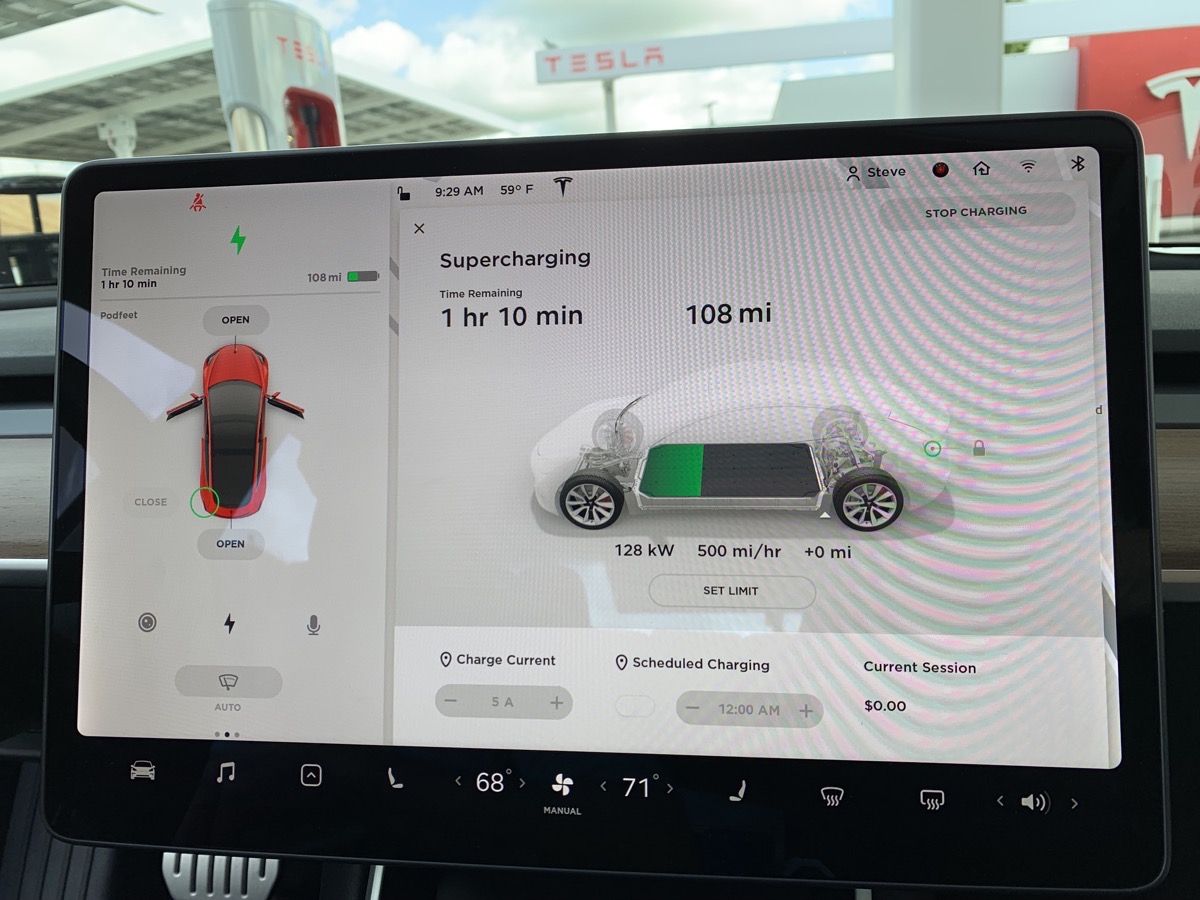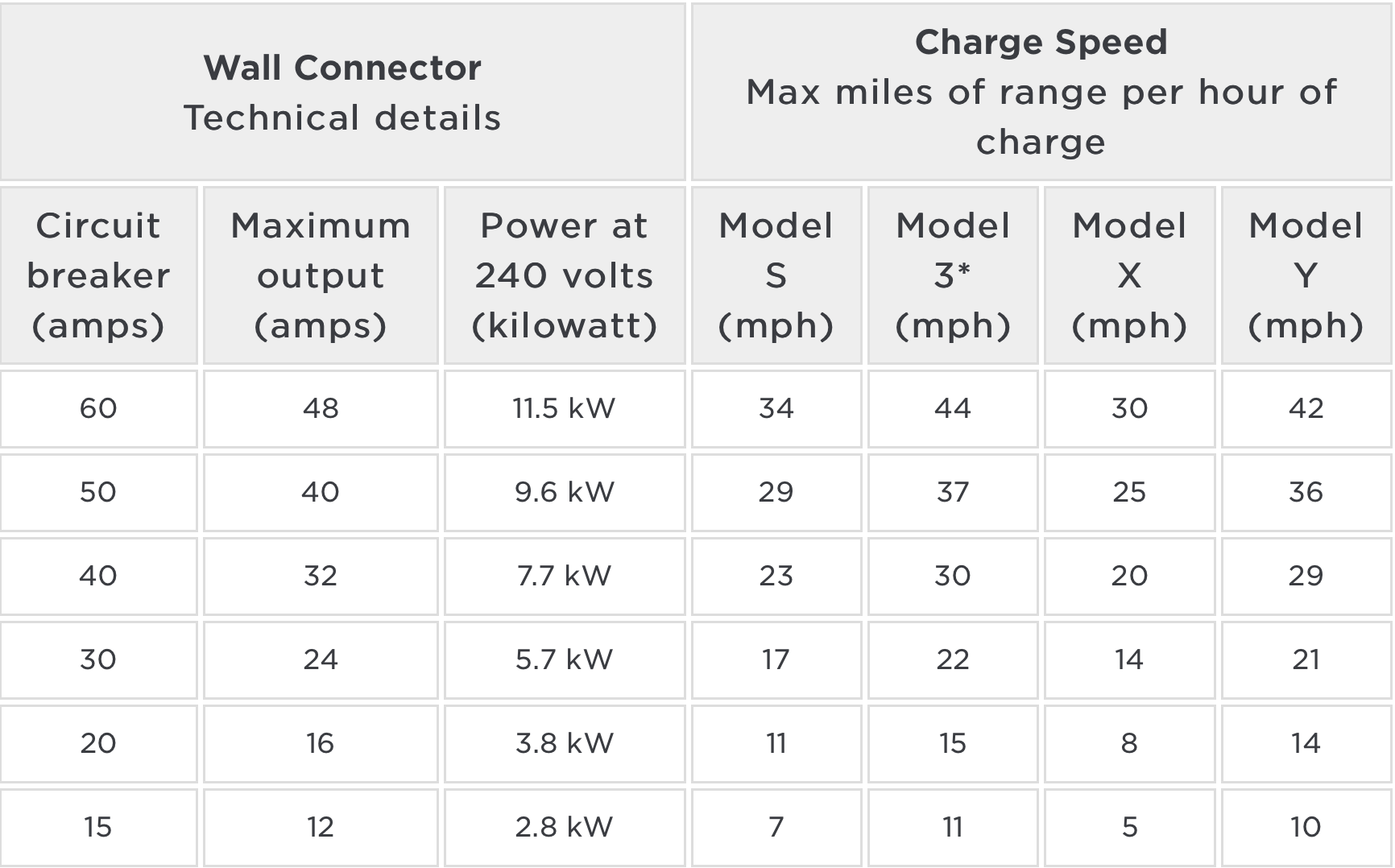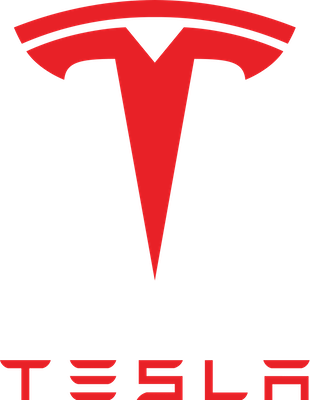My father had a lot of weird sayings that I didn’t completely understand. For example, when I was misbehaving, he would threaten me with “I’m going to cut you off too short to hang up!” When I asked a question that was too vaguely worded to have a unique answer, he would say, “How big is a lump of coal?”
This week in our Facebook group (podfeet.com/facebook), Denise asked me how long it takes to charge the Tesla Model 3 and I answered, “How big is a lump of coal?” I’m sure she appreciated that answer as much as I did when my dad would say it. I’d like to be a little more helpful than that in this article.
Charge Profile

Let’s start with some discussion of the charging profile of batteries in general because it’s fundamental to understanding the answer to Denise’s question. According to electrek.co/…, Tesla uses lithium-ion batteries (now with less cobalt!).
I’ve included a graph in the shownotes from a great site to learn about batteries called Battery University. In the chart, you can see the charge time across the horizontal axis and the charge capacity by percentage on the vertical axis. There’s a lot of other things plotted on this graph, but the Charge Capacity line is the one that interests us. From 0% to around 60-70% charge, the rate of increase in capacity is linear. That is, every minute of charge causes the same percentage increase in charge. But at around 65%, the rate of change starts to slow down.
In this particular battery test, the time to get to 100% is 3 hours. In the first .75 hours, the battery gets up to 70% of full charge, but to gain an additional 25% takes another .75 hours. The last 5% takes 1.5 hours. I’m sure you’ve experienced this with your cell phones where a 15-30 min charge will give you a good boost when your battery is low, but it seems to take forever to get to 100% charged.
If I was to answer Denise’s question on how long it takes to charge, I’d need to know what percentage charge the car had when it started charging and how much it needed to have when it stopped charging. Probably not going to run the battery to zero (that’s very bad for Li-Ion batteries), and probably not going to sit around waiting for it to get to 100% either. So how big is a lump of coal anyway?
Types of Chargers
Electric Vehicle charging is highly dependent on the charger you use on the car. They rate chargers in kW (kilowatt) which we have learned in previous battery discussions is actually a charging speed. When you plug the Model 3 into a charger, you can see the kW speed of the charger, but you can also see it in a much more sensible metric, miles per hour. I know that sounds funny but you don’t really think in kW when you’re wondering how long it will take you to charge up to go a specific distance.
Let’s talk about two dramatically different examples. In a US household, our outlets are normally 110 Volts. If you plug a Tesla into one of these outlets, you can expect to charge at 3 miles per hour. Now I don’t drive very far, so getting 24 miles of charge while I sleep every night might not be too bad, but that’s really inefficient. My long-range Model 3 has a range of 310 miles so my answer to Denise would be several days to charge from 0-100%.

At the opposite end of the spectrum, you have what Tesla calls Superchargers. These things are beasts as Chris Ashley would say. We took a recent road trip with the Model 3 and stopped at a Supercharger in a town called Lebec along Interstate 5. I took a photo of the screen in the Tesla that shows my battery being charged at 500 mi/hr! If I had come in at 0% (which I didn’t) and that charge rate was linear (which we know it’s not), my answer to Denise would be 37 minutes!
While we’re on the topic, the screen when you’re charging is really cool. It shows a graphic of your car with the seats missing and the battery that’s underneath showing. As your car charges up, the battery turns green from left to right until it’s all green. Under the car, there’s a “set limit” button. When you tap that, you can slide down from the right to change from charging 100% to only charging to 90%.
Tesla recommends when you’re charging daily for toodling around town, you don’t want to charge the battery to 100%. Battery University talks about that too – keeping the battery at 100% is very bad for Li-Ion batteries. But when you’re going on a long road trip, you want all the miles you can get so you can drag that limit to 100%.
Back to the Supercharger speed of charging. We know it doesn’t stay to 500 mi/hr for the whole charge, and in my very few experiences, I’ve seen it drop to around 340 mi/hr as I get up to around 60-70%.
But another thing can change the charge speed. When you drive into a Tesla Supercharging station, you’ll notice that the chargers have numbers and letters, A or B. So you’ll see 9A and 9B next to each other. If you charge your car in slot A while someone else is in slot B, you’ll actually be sharing charging. I was watching mine at 500 mi/hr and a guy pulled into the stall next to me and when he started charging I saw it drop to 320 mi/hr. Not half speed but a definite drop.
So now I have to ask Denise, “How much charge did I start with, how much was my goal, was it on 110v at home or a Supercharger and was I sharing or did I have one all to myself?” All that before I can answer her question.
But wait, there’s a lot in-between 110V at home and Supercharging. In reality, you’d have to be pretty desperate to charge at 110V at home. You can buy a wall charger for your house to condition the power for a 240V outlet. It turns out that two things end up important in the next equation: Volts and Amps. When an electrical engineer in your house says 240V, he or she may also say 220V. It drives me bananas how electrical engineering has so many variables. Maybe it wasn’t that much of a joke when Michael Keaton in the movie Mr. Mom was asked whether he was wiring in 220 and he replied, “Yeah. 220… 221, whatever it takes.”
In any case, we bought the wall charger unit from Tesla and had an electrician run the power for us. I ran a speed test on it for you so we could talk about a middle ground. On the screen, I can see I’m drawing 40 Amps at 227 Volts. Seriously? 227? In any case, the screen shows I’m gaining range at 33 mi/hr.
A 110V outlet usually supplies 20A and gives us around 3 mi/hr while a 227V 40A charger gives us 10x the speed. If it was linear (which it’s not) and if I started at 0 and went to 100% which I won’t, I can charge my car in about 9 hours at home. We can probably surmise that in normal usage, I could charge it from pretty low to the 90% recommendation at night when I’m sleeping and dreaming of current and voltage.
But there aren’t just Superchargers or home chargers. It turns out you can charge lots of other places on completely different kinds of chargers. I looked in the ChargePoint app Rod Simmons recommended, and there’s a 20 mph charger around the corner from my house at a BMW dealer. A Honda dealer another few blocks away has a charger that will do 150 mi/hr. I better stop on the different chargers, don’t you think?
What Kind of Car Is It?

Here’s yet another variable to answering Denise’s question. Which Tesla model you buy changes how long it takes to charge. On the site where Tesla sells the wall charger, they’ve got a chart that quantifies the rate at which your car will charge depending on how many Amps your circuit breaker can supply at 240V. Oh yeah, those Amps change the answer too. But here’s the even more interesting thing on the chart. It shows the miles per hour gained at the same rate of charge (in kW) as being different depending on which Tesla model you have.
For example, on my 50A circuit breaker (which can only deliver 40A because electrical engineers are annoying), at 240V the wall charger can deliver 9.6kW. For that configuration, the Model 3 gains 37 mi/hr, the Model S gets less at 29 mi/hr, and the Model X gets even less at 25 mi/hr.
Steve and I began speculating on why the same rate of charge (9.6kW) would cause differing increases in range of the vehicle. We surmised that the difference is in how much the car weighs. The heavier the vehicle, the less distance it can go on the same bucket of electrons. The Model X is a relatively large SUV, the Model S is a very large sedan, and I would put the Model 3 in the mid-size sedan category.
I looked up the weight of the standard range Model S and Model 3. The Model 3 weighs 76% of what the Model S weighs. The Model S gains 78% of the range per hour as the Model 3. QED, Steve and I are correct that the range gain per hour is highly dependent on the weight of the car.
I just realized, the chart could be made more complicated. Each of the three Tesla models comes in a Standard or Extended range. I’m betting that since I have the Extended Range, that’s why my car gets 33 mi/hr instead of the 37 mi/hr in the chart!
How Cold Is It?
In my studies at Battery University, I learned something really interesting about Li-Ion batteries. They don’t charge at all if they’re at or below 0°C, also known as the freezing point for water. Li-Ion batteries are also not fond of charging above 45°C (113°F). Tesla pushed out a firmware update to their cars just this quarter that does something fascinating to help with this problem. In the navigation system on a Tesla, you are offered the option to navigate to Superchargers. If you select one to which you want to navigate, the vehicle will actually use its HVAC system to cool or heat the battery to a temperature that will ensure the best charging experience. How cool is that?
Bottom Line

So Denise, in answer to your question of how long it takes to charge, I have a few questions for you first. All I need to know is how charged it was when you start, how high you want it charged, what type of charger you’re going to use, whether you’ll be sharing with someone else, which Tesla model you mean and how long of a range was purchased, and what the temperature outside will be?
A more helpful answer would be that at home, I charge while I sleep and it’s always full when I wake up. And on the road, I stop for a half hour or so and have a cup of coffee or a sandwich and take a bio break every few hours and I’m on my merry way. Oh, and you should see the luxuries at some of the Supercharger stations…


I’m enjoying all your Tesla updates! Keep em coming.
Yes me too